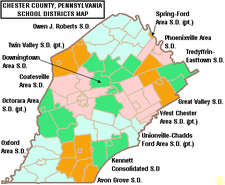Church Farm School
This article needs additional citations for verification. (December 2012) |
| Church Farm School | |
|---|---|
 | |
| Address | |
 | |
1001 East Lincoln Highway , 19341 | |
| Information | |
| Type | Independent Boarding and Day School, Boys |
| Established | 1918 |
| Headmaster | Edmund K. Sherrill II |
| Grades | 9-12 |
| Number of students | 190 |
| Average class size | 12 |
| Student to teacher ratio | 1:7 |
| Campus | Suburban |
| Campus size | 250 acres (1.0 km2) |
| Color(s) | Maroon and Grey |
| Athletics conference | PIAA District 1, Bicentennial Athletic League |
| Mascot | Griffin |
| Newspaper | Greystock News |
| Yearbook | CFS Griffin |
| Endowment | $120-150 Million |
| Website | [1] |
Church Farm School Historic District | |
 | |
| Location | US 30, West Whiteland, Pennsylvania |
| Coordinates | 40°1′54″N 75°35′41″W / 40.03167°N 75.59472°WCoordinates: 40°1′54″N 75°35′41″W / 40.03167°N 75.59472°W |
| Area | 19.7 acres (8.0 ha) |
| Built | 1918 |
| Architect | Medary, Milton |
| Architectural style | Tudor Revival, Collegiate Gothic |
| MPS | West Whiteland Township MRA |
| NRHP reference No. | 84002733[1] |
| Added to NRHP | October 26, 1984 |
The Church Farm School (CFS) is a private secondary Christian school in West Whiteland Township, Pennsylvania, outside of the Exton census-designated place.[2][3] In 1985, the campus was listed as a historic district by the National Register of Historic Places.
History[]
The school was founded in 1918 by Charles Shreiner. Shreiner, an Episcopal clergyman, established the school in Glen Loch (now Exton) Pennsylvania, on Route 30 (Lincoln Highway), as a boarding school for boys from single parent homes, primarily those without fathers. The sons of clergy, members of the armed services, and police officers were a second focus of the school in its early days. Shreiner, because of his strict belief in the importance of discipline and a strong work ethic, was known to the boys as the "Colonel."[4]
Shortly after its founding, the school acquired the Benjamin Pennypacker House property.[5] The school integrated in 1963. After Shreiner's death in 1964, the Board of Directors placed the School under the direction of his son, Charles Shreiner, Jr., a World War II veteran, who served until retirement in 1987. The school's third headmaster, Charles "Terry" Shreiner, III, the founder's grandson, led the school from 1987 and retired in 2009. The School was then led by an interim headmaster, Thomas Rodd, Jr., who was replaced by Edmund K. Sherrill II, an Episcopal clergyman, in July 2009.
Over the first half of its history, the School's campus grew to 1700 acres, on which a large farm was operated with the help of the students. Each boy was required to work half of each school day and full-time for half of each summer. This enterprise included a large dairy farm and hog raising operation and produced many crops. The agricultural activities were gradually phased out, beginning in the mid-1970s, with most of the remaining farm land being sold off to developers in the late 1990s. The dairy barns and silos remain as a memorial of the agricultural era of the school's history.
References[]
- ^ "National Register Information System". National Register of Historic Places. National Park Service. March 13, 2009.
- ^ "2010 CENSUS - CENSUS BLOCK MAP: Exton CDP, PA." U.S. Census Bureau. Retrieved on October 9, 2018. "West Chester Area Council of Governments Map." On the website of West Goshen Township. Retrieved on September 26, 2018. This shows the boundaries of West Whiteland Township.
- ^ Home Archived 2018-11-13 at the Wayback Machine. Church Farm School. Retrieved on October 9, 2018. "Church Farm School | 1001 E. Lincoln Hwy. | Exton, Pennsylvania 19341"
- ^ Diane Snyder and Martha Wolf, 1984, NRHP Nomination Form for the School at Church Farm Enter "public" for ID and "public" for password to access the site.
- ^ "National Historic Landmarks & National Register of Historic Places in Pennsylvania" (Searchable database). ARCH: Pennsylvania's Historic Architecture & Archaeology. Retrieved 2012-11-02. Note: This includes M. L. Wolf and Brandywine Cons. (December 1981). "Pennsylvania Historic Resource Survey Form: Benjamin Pennypacker House" (PDF). Retrieved 2012-11-05.
External links[]
- Christian schools in Pennsylvania
- Private high schools in Pennsylvania
- Boarding schools in Pennsylvania
- Preparatory schools in Pennsylvania
- Nondenominational Christian schools in the United States
- Educational institutions established in 1918
- Schools in Chester County, Pennsylvania
- School buildings on the National Register of Historic Places in Pennsylvania
- Tudor Revival architecture in Pennsylvania
- School buildings completed in 1918
- Private middle schools in Pennsylvania
- 1918 establishments in Pennsylvania
- Episcopal schools in the United States
- Boys' schools in the United States
- Historic districts on the National Register of Historic Places in Pennsylvania
- National Register of Historic Places in Chester County, Pennsylvania




